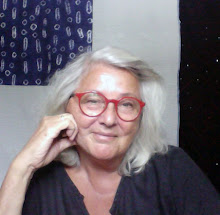This article appeared in The Manitoulin Expositor, July 23. It was written by the editor of the paper, Alicia McCutcheon
"Come and find a quiet centre in the crowded life we lead, find the room for hope to enter, find the frame where we are freed" the congregation and choir of the Little Current United Church sang during the dedication service of four richly textured, large pieces of community-made textile art that have come to be known as meditation panels at last sunday morning's church service.
In 2009, when textile artist Judy Martin first met with the group of church women who would advise her abut a community artwork project she proposed (Barbara cranston, Marion Henry, Mary Marg Walsh, Julia McCutcheon and Rev. Faye Stevens) they told her about the mandate of the United Church of Canada, the ideas behind Manitou Conference and the mission statement of the Little Current United church. Ms. martin was getting background about the place that would house her proposed Circle Project for the next four years, hosting weekly stitching groups that became so much more and would eventually become the final home for the four works of art created. Oh, they added, "We like to sing."
"Yes, you do love to sing, Little Current United church," Ms Martin said during the dedication service, following the hymn. "Your singing is joyous and full of life. You sing in so many ways - pie baking, yard sale minding, plant selling, fish dinner preparing, attending church regularly, caring deeply."
Ms Martin shared that the project had its origins as a theoretical exercise for a course she was taking at the time in liturgical art. It was ideological in its origins, but her vision was to make it a reality. "When the Manitoulin Circle Project morphed from being something that only had to be an idea on paper (for the university) into something that this church would actually carry out, I can't recall," she said. "My liturgical course was finished in october 2009 when we started stitching. I went on to study other courses for that degree and graduated from it in London, England in June 2012."
"This particular project was all theoretical for the university." Ms Martin continued. "It did not have to actually go ahead for me to receive a mark --- but it did go ahead. It went ahead from September 2009 and continued on. That was not me. That was you. The many people who supported the idea of a wider community coming into this building to work together and create contemporary art using materials rich with past domestic ritual. That was you, little Current United Church. That was you, dear women and men who placed their hands on this work every week for four years."
Ms Martin's proposal, made in August 2009, stated that the project would take two years with the installation planned for 2011. The panels were finally finished in 2013, four years later, (taking two additional years of steady stitching by many hands) in time to meet a deadline for the Thunder Bay ARt Gallery where the four panels went on display last September and then on to the Art Gallery of Sudbury in the winter. After a brief stop at their home at the church, the panels will again be on the move with at least four more tours, but this church, Ms Martin said, is their home. Over the weekend, the church and the panels were also a stop on the Manitoulin Art Tour.
She explained that the panels were made for this particular church, and for those particular walls in the sanctuary. They are meditation panels, she said. "Perhaps they work best if you are alone with them, seatedin one of the pews, feeling their accumulated touch. They are also intended to work when you are together as a congregation, helping each to listen to and meditate on the ideas presented during the service."
The wall behind the choir, which houses the cross, is a bright blue and this colour appears in all of the panels.
"The design element of the circle that is in every panel is one of the simple shapes that Carl Jung identified as being within the collective unconscious" Ms Martin shared. "Every one. Every. One. Around the world, from all periods of time, understands this shape. She explained that the circle represents wholeness and completion. "The circle is the most natural shape. It is perfect. Because there is no beginning or end of a circle, it represents eternity. The circle also refers to the circle of women who participated in the construction of these pieces every Thursday. Manitoulin Island is a circle. The earth is a circle."
The square, the shape of the panel, represents solidity, boundaries. "If the cirlce is heaven, the square is earth."
The panels all contain a message of environmental appreciation, Ms Maritn continued, as they were made with donated and thrift shop damask tablecloths and domestic textiles such as lace doilies, women's handkerchiefs, and wool blankets. Their titles are intended to raise awareness about caring for the earth. "Earth Ark. Mended World. Precious WAter. Layers of Time."
"One thing that handmade items do is hold time. They catch it." she continued. "Those four years of time are caught in these panels and saved for future generations to appreciate. The people who touched and worked on these pieces, who even just walked by the quilt while it was in the frame in the church hall, will look at these panels and remember something about this particular present time in our lives and in the church's life." This is life affirming work. To slowly make things by hand shows faith that there will be a place for these things in the future."
Subscribe to:
Post Comments (Atom)














No comments:
Post a Comment